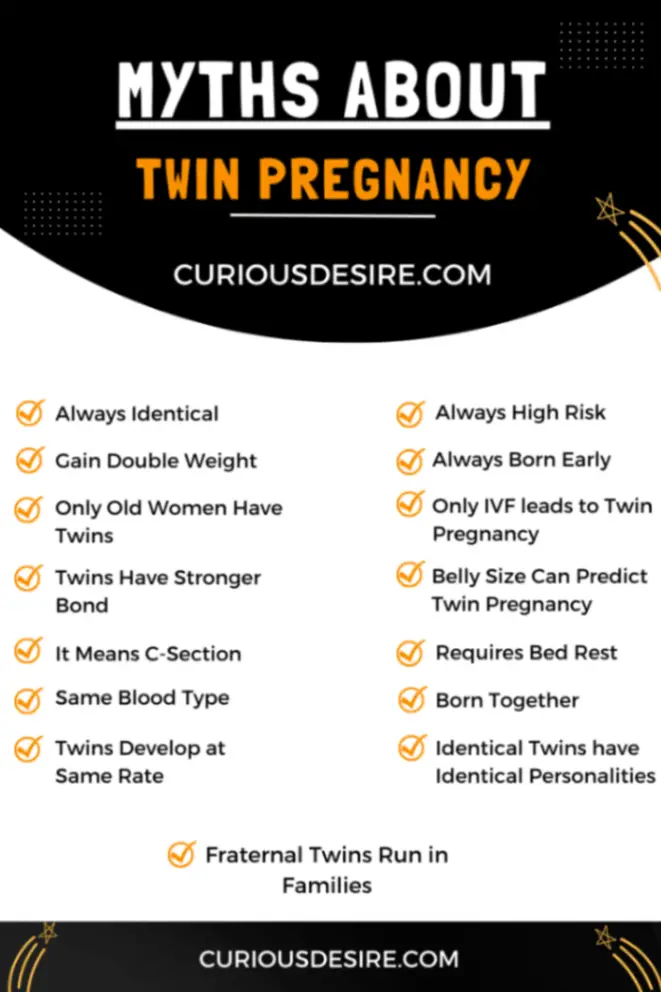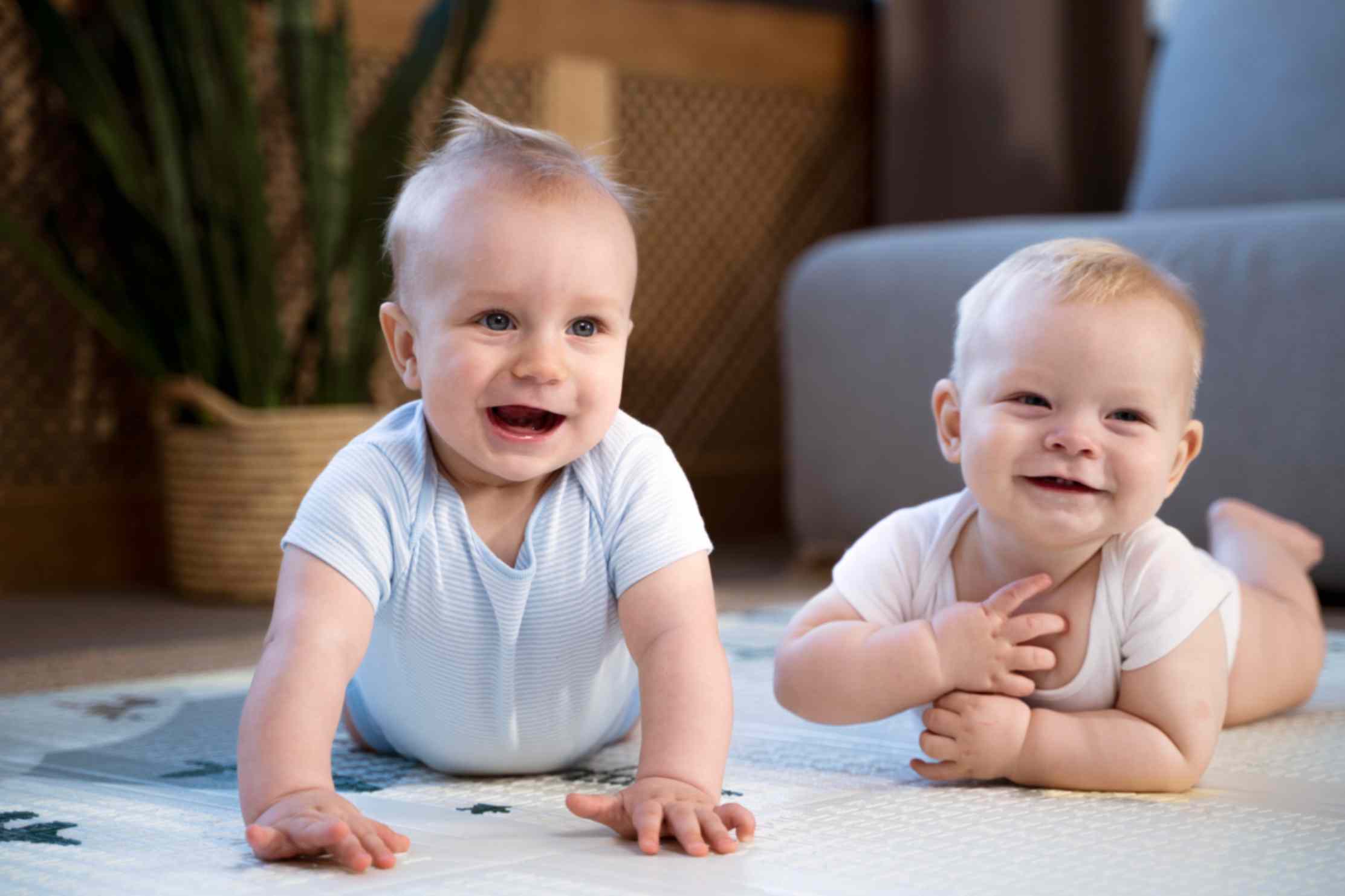Pregnancy, in itself, is a remarkable journey filled with its own set of challenges and joys. However, when it comes to twin pregnancies, the intrigue and curiosity seem to double.
Expecting twins is an exciting and unique experience that comes with its own set of challenges and joys.
From tales of extraordinary cravings to exaggerated complications, the world of twin pregnancy is shrouded in misinformation.
In this blog, we will debunk some of the most common myths about twin pregnancies and provide accurate information to help you confidently navigate this special journey.
5 most common myths about twin pregnancy:
- All twin pregnancies are identical
- Only older women can have twins
- Twins are always born early
- Twins have Identical Personalities
- All twins have the same blood type

Myth 1: All Twin Pregnancies Are Identical
One of the most common misconceptions surrounding twin pregnancies is the belief that all twins are identical.
In reality, there are two types of twins:
- Identical (monozygotic)
- Fraternal (dizygotic).
Identical twins occur when a single fertilized egg splits into two embryos, resulting in two genetically identical babies.
On the other hand, fraternal twins develop from two separate eggs fertilized by two different sperm cells, making them genetically no more similar than any other siblings.
Understanding this distinction is crucial, as it impacts various aspects of pregnancy, including prenatal care and potential complications.
Myth 2: Twin Pregnancies Are Always High-Risk
While it’s true that twin pregnancies are generally considered higher risk compared to singleton pregnancies, not all twin pregnancies encounter complications.
With proper prenatal care and monitoring, many twin pregnancies progress smoothly, resulting in healthy babies and mothers.
However, it’s essential to acknowledge the increased likelihood of certain complications, such as preterm birth, gestational diabetes, and preeclampsia, and to address them through proactive healthcare measures.
Myth 3: You’ll Always Gain Double the Weight with Twins
Weight gain during pregnancy is a natural and necessary aspect of nurturing a growing baby.
However, the notion that women carrying twins should expect to gain double the weight is misleading.
While twin pregnancies may necessitate additional weight gain compared to singleton pregnancies, the exact amount varies depending on pre-pregnancy weight, maternal health, and nutritional needs.
Rather than focusing solely on the number on the scale, healthcare providers emphasize the importance of gaining weight gradually and maintaining a balanced diet to support the health of both mothers and babies.
Myth 4: Twin Pregnancies Guarantee Double Trouble
The idea that twin pregnancies are inherently more challenging and chaotic than singleton pregnancies perpetuates the stereotype of double trouble.
While it’s true that raising twins presents unique logistical and emotional challenges, many parents of twins attest to the incomparable joy and fulfillment that come with the experience.
From shared milestones to built-in playmates, twin pregnancies offer a special bond that transcends the challenges.
With support from family, friends, and healthcare professionals, parents can navigate the journey of raising twins with confidence and resilience.
Myth 5: You Can Determine the Sexes of Twins Based on Symptoms
Predicting the sexes of twins based on pregnancy symptoms is a popular yet scientifically unfounded belief.
While anecdotal evidence may suggest correlations between certain symptoms and the sexes of twins, such claims lack empirical support.
The sex of each baby is determined by genetic factors, specifically the chromosomes contributed by the parents.
Ultrasound scans conducted during prenatal care appointments provide the most reliable means of identifying the sexes of twins, offering expectant parents the opportunity to prepare for their unique family dynamic.
Myth 6: Only Older Women Can Have Twins
While it’s true that the likelihood of having twins increases with maternal age, particularly over the age of 35, twins can occur in women of all ages.
The increase in twinning with age is largely due to hormonal changes that can lead to the release of multiple eggs during ovulation.
However, other factors such as genetics and ethnicity also influence the likelihood of conceiving twins.
For example, women of African descent are more likely to have twins compared to women of Asian descent.

Myth 7: Fraternal Twins Always Run in Families
Fraternal twins occur when a woman releases multiple eggs during ovulation, each of which can be fertilized by separate sperm.
While there is a genetic component to hyperovulation, it’s not the only factor.
While a family history of fraternal twins can increase the likelihood of a woman also having fraternal twins, it’s not a guarantee.
Hyperovulation can occur spontaneously without a family history of twins, making it possible for fraternal twins to occur in families where they haven’t before.
Myth 8: Only IVF Leads to Twin Pregnancy
While it’s true that IVF increases the chance of twins because multiple embryos are often transferred to increase the chances of successful implantation, natural conception can also result in twins.
Factors such as maternal age, genetics, and the use of fertility medications can increase the likelihood of conceiving twins without the use of IVF.
Fertility drugs such as clomiphene citrate can stimulate the ovaries to release more than one egg during ovulation, increasing the chance of conceiving fraternal twins.
Myth 9: Twins are Always Born Early
While twins are more likely to be born prematurely compared to singletons, not all twin pregnancies end prematurely.
With proper prenatal care and monitoring, many twin pregnancies can progress to full term, resulting in healthy, full-term births.
Factors such as the health of the mother, the type of twins (fraternal or identical), and any complications during pregnancy can influence the timing of birth.
Close monitoring by healthcare providers can help identify and manage potential complications, improving the chances of a successful full-term twin pregnancy.
Myth 10: Twins Mean Automatic C-Section
While the idea of delivering twins via cesarean section might seem like the safest option, it’s not always necessary.
Many twin pregnancies progress without complications that would necessitate a c-section.
The American College of Obstetricians and Gynecologists (ACOG) supports the idea of vaginal delivery for most uncomplicated twin pregnancies.
Factors such as the position of the babies, the mother’s health, the babies’ size, and the labor progress all play a role in determining the safest delivery method.
If both twins are positioned head down (vertex presentation) and there are no other complications, a vaginal birth can be a viable and safe option.
However, complications arise during labor, such as fetal distress or issues with the positioning of the babies. In that case, a c-section may be recommended to ensure the safety of both the mother and babies.
Myth 11: All Twin Pregnancies Require Bed Rest
While bed rest may be prescribed in certain cases to manage complications such as preterm labor or high blood pressure, it’s not a blanket recommendation for all twin pregnancies.
Bed rest itself can pose risks, including muscle weakness, bone loss, and psychological stress.
Therefore, healthcare providers typically reserve bed rest for specific situations where the benefits outweigh the potential risks.
Staying active and maintaining a healthy lifestyle, as long as it’s safe, is generally encouraged during pregnancy, including twin pregnancies, to promote overall well-being.
Myth 12: Twins Are Always Born Smaller
With proper prenatal care, including adequate nutrition and monitoring of fetal growth, many twins can be born at healthy weights.
Factors such as gestational age, maternal health, and intrauterine growth patterns influence the size of twins at birth.
Some twins may even be born larger than average, especially if they are born at or near full term.
Healthcare providers closely monitor fetal growth during prenatal visits to ensure that both twins are developing appropriately.
If any concerns arise regarding fetal growth or well-being, appropriate interventions can be implemented to optimize outcomes for both babies.
Myth 13: Twins Have the Same IQ
Environmental factors, such as education, nutrition, stimulation, and early childhood experiences, also significantly influence cognitive development.
Even identical twins, who share the same genetic makeup, can have different IQs due to these environmental factors.
For example, if one twin receives more educational opportunities or experiences different levels of stress during childhood, it can impact their cognitive abilities differently.
Personality traits, motivation, and interests can also contribute to variations in IQ between twins.
Myth 14: Eating Double the Food for Twin Pregnancy
During pregnancy, women must consume a balanced diet that provides essential nutrients for fetal development.
While carrying twins may increase the need for certain nutrients and calories compared to a singleton pregnancy, it doesn’t necessarily mean eating twice as much food.
Healthcare providers typically recommend modest increases in calorie intake and adjustments to nutrient intake based on individual needs and gestational stage.
Eating a nutrient-rich diet that includes a variety of fruits, vegetables, lean proteins, whole grains, and dairy products is more important than simply doubling food consumption.
Consuming excessive calories can lead to unnecessary weight gain and potential health risks for both the mother and babies.
Myth 15: Twins Always Have a Stronger Bond
While twins often share a unique and close relationship due to their shared experiences and closeness in age, assuming that all twins have a stronger bond overlooks the diversity of sibling relationships.
Like any siblings, twins may have varying degrees of closeness influenced by factors such as personality differences, individual interests, and external influences.
While some twins may indeed share an inseparable bond and have an intuitive understanding of each other, others may have more typical sibling dynamics characterized by love, competition, and occasional conflicts.
The strength of the bond between twins can evolve as they navigate different life stages and experiences, just like any other siblings.
